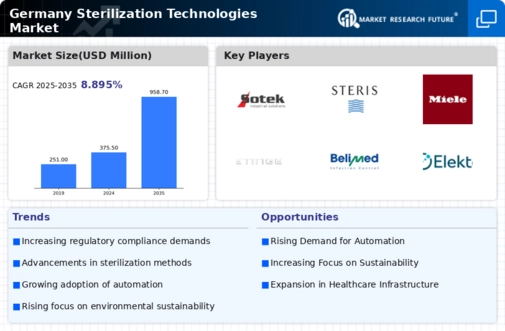Rising Healthcare Expenditure
The increasing healthcare expenditure in Germany is a pivotal driver for the sterilization technologies market. As the government and private sectors allocate more funds towards healthcare, the demand for advanced sterilization solutions rises. In 2025, healthcare spending in Germany is projected to reach approximately €500 billion, reflecting a growth rate of around 4% annually. This surge in investment is likely to enhance the capabilities of healthcare facilities, necessitating the adoption of effective sterilization technologies to ensure patient safety and compliance with health regulations. Consequently, the sterilization technologies market is expected to benefit from this trend, as hospitals and clinics seek to upgrade their sterilization processes to meet the growing demands of a modern healthcare environment.
Regulatory Framework Enhancements
Enhancements in the regulatory framework surrounding sterilization practices are influencing the sterilization technologies market. In Germany, regulatory bodies are continuously updating guidelines to ensure the highest standards of safety and efficacy in sterilization processes. These regulations compel healthcare facilities to adopt advanced sterilization technologies that comply with stringent requirements. As a result, the sterilization technologies market is expected to grow as manufacturers innovate to meet these regulatory demands. The emphasis on compliance not only drives market growth but also fosters a culture of safety within healthcare settings, ultimately benefiting patient outcomes.
Growing Demand for Infection Control
The growing demand for infection control measures is a significant driver for the sterilization technologies market. With rising awareness about healthcare-associated infections (HAIs), healthcare facilities in Germany are prioritizing sterilization processes to mitigate risks. The sterilization technologies market is expected to witness a growth rate of 5% annually as hospitals implement stringent infection control protocols. This trend is further supported by regulatory bodies emphasizing the importance of effective sterilization in maintaining patient safety. As a result, the market is likely to see increased investments in sterilization technologies, ensuring that healthcare providers can meet the evolving standards of infection control.
Technological Advancements in Sterilization
Technological advancements play a crucial role in shaping the sterilization technologies market. Innovations such as low-temperature plasma sterilization and advanced ethylene oxide systems are gaining traction in Germany. These technologies not only improve efficiency but also reduce the environmental impact associated with traditional methods. The market for sterilization technologies is projected to grow at a CAGR of 6% from 2025 to 2030, driven by the need for more effective and sustainable sterilization solutions. As healthcare providers increasingly adopt these advanced technologies, the sterilization technologies market is likely to expand, offering new opportunities for manufacturers and suppliers in the industry.
Increased Focus on Environmental Sustainability
The increased focus on environmental sustainability is emerging as a key driver for the sterilization technologies market. In Germany, there is a growing recognition of the need for eco-friendly sterilization methods that minimize waste and reduce carbon footprints. This shift is prompting healthcare facilities to explore alternatives to traditional sterilization processes, such as steam sterilization and hydrogen peroxide vaporization. The sterilization technologies market is likely to expand as manufacturers develop sustainable solutions that align with environmental goals. This trend not only addresses regulatory pressures but also resonates with the values of healthcare providers and patients alike, fostering a more sustainable approach to sterilization.


















Leave a Comment